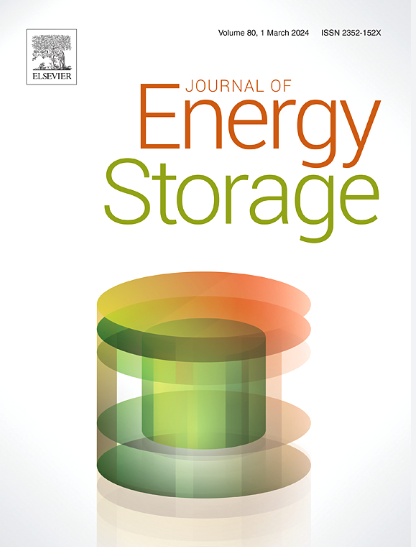Upside-down sodium ion capacitor: A non-presodiated system based on Na3V2O2(PO4)2F and biomass derived activated carbon
IF 8.9
2区 工程技术
Q1 ENERGY & FUELS
引用次数: 0
Abstract
Hybrid systems between batteries and supercapacitors are designed to bridge the gap between both technologies, developing high-power, high-energy, and long cycle life energy storage devices. Moreover, in the urgent need to transition to a more sustainable energy model, sodium-based chemistries are an excellent alternative to lithium-based technologies. While various approaches have been tried in Na-ion capacitor (NIC) cell design, the upside-down NIC configuration remains underexplored. This consists of using a Na-containing battery-type cathode instead of an anode, which eliminates problems such as the need for pre-sodiation or Na-plating. This setup also allows the electrolyte concentration to stay stable, with ions exhibiting a rocking-chair motion, ensuring stable ionic conductivity during cycling. However, the potential window of these systems can be limited by the formation of the SEI on the capacitive negative electrode. Therefore, the aim of this paper is to explore the limitations of activated carbon (AC) in upside-down NICs through ex-situ X-ray photoemission spectroscopy (XPS) characterization and comprehensive monitoring of the electrode under various full-cell conditions, thereby assessing how far this configuration can be pushed in terms of energy. The proposed system features a high-rate capability cathode, a Na3V2O2(PO4)2F/C composite prepared via a novel one-step microwave synthesis, which delivers 64 mAh g−1 at 50C. The negative electrode employs a dried olive pits-derived AC with a surface area of 2138 m2 g−1. Together, they enable a full cell achieving up to 69 Wh kg−1 at 19 W kg−1 and 29 Wh kg–1 at 4915 W kg−1, with an impressive capacity retention of 74 % after 10,000 charge-discharge cycles.
倒置钠离子电容器:一种基于Na3V2O2(PO4)2F和生物质衍生活性炭的非沉淀体系
电池和超级电容器之间的混合系统旨在弥合这两种技术之间的差距,开发高功率,高能量和长循环寿命的能量存储设备。此外,在迫切需要向更可持续的能源模式过渡的情况下,钠基化学物质是锂基技术的绝佳替代品。虽然在钠离子电容器(NIC)电池设计中已经尝试了各种方法,但倒置的NIC配置仍未得到充分探索。这包括使用含钠电池类型的阴极而不是阳极,这消除了诸如需要预钠化或钠镀等问题。这种设置还允许电解质浓度保持稳定,离子表现出摇椅运动,确保在循环过程中稳定的离子电导率。然而,这些系统的电位窗口可能会受到电容负极上SEI形成的限制。因此,本文的目的是通过非原位x射线光电发射光谱(XPS)表征和各种全电池条件下电极的综合监测来探索活性炭(AC)在倒置NICs中的局限性,从而评估这种配置在能量方面可以推动到什么程度。该系统具有高倍率性能的阴极,即通过新型一步微波合成制备的Na3V2O2(PO4)2F/C复合材料,在50℃下可提供64 mAh g−1。负极采用干燥的橄榄坑衍生AC,其表面积为2138 m2 g−1。总之,它们使一个完整的电池在19 W kg - 1时达到69 Wh kg - 1,在4915 W kg - 1时达到29 Wh kg - 1,在10,000次充放电循环后,容量保持率达到74%。
本文章由计算机程序翻译,如有差异,请以英文原文为准。
求助全文
约1分钟内获得全文
求助全文
来源期刊

Journal of energy storage
Energy-Renewable Energy, Sustainability and the Environment
CiteScore
11.80
自引率
24.50%
发文量
2262
审稿时长
69 days
期刊介绍:
Journal of energy storage focusses on all aspects of energy storage, in particular systems integration, electric grid integration, modelling and analysis, novel energy storage technologies, sizing and management strategies, business models for operation of storage systems and energy storage developments worldwide.
 求助内容:
求助内容: 应助结果提醒方式:
应助结果提醒方式:


